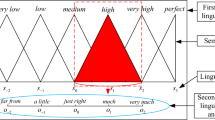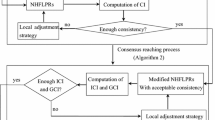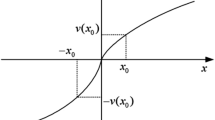Abstract
In real-world complex group decision-making problems, preference inconsistency and opinion conflict are common and crucial challenges that need to be tackled. To promote consensus reaching, a novel group consensus reaching model is constructed considering individual satisfaction and group fairness. This study focuses on managing the group consensus reaching process based on flexible and adaptable information, modelled as distributed linguistic preference relations (DLPRs). First, a building process for DLPRs is discussed by integrating cumulative distribution functions converted from single linguistic term sets, hesitant fuzzy linguistic term sets, and comparative linguistic expressions. Furthermore, a two-stage consistency improvement method is proposed, which makes a trade-off between the frequency and magnitude of adjustments. Finally, we establish an improved group consensus model to balance individual satisfaction and group fairness, where individual satisfaction is measured by the deviation between the original and revised preferences and group fairness is measured by the deviation between individual satisfactions. The emergency response plan selection is conducted to show the validity and advantages of the proposed approach.
Graphical Abstract









Similar content being viewed by others
Explore related subjects
Discover the latest articles, news and stories from top researchers in related subjects.References
Bertsimas D, Farias VF, Trichakis N (2012) On the efficiency-fairness trade-off. Manage Sci 58(12):2234–2250
Chen L, Xu HY, Pedrycz W (2023) Conflict analysis based on a novel three-way decisions graph model for conflict resolution method under hesitant fuzzy environment. Inf Fus 100:101936
Chen X, Liu PJ, Wu ZB, Pedrycz W (2020) Controlling the worst consistency index for hesitant fuzzy linguistic preference relations in consensus optimization models. Comput Ind Eng 143:106423
Chen ZS, Zhang X, Rodríguez RM, Pedrycz W, Martínez L, Skibniewski MJ (2022) Expertise-structure and risk-appetite-integrated two-tiered collective opinion generation framework for large-scale group decision making. IEEE Trans Fuzzy Syst 30(12):5496–5510
Chen ZS, Zhu Z, Wang XJ, Chiclana F, Herrera-Viedma E, Skibniewski MJ (2023) Multiobjective optimization-based collective opinion generation with fairness concern. IEEE Transact Syst Man Cybern Syst 53(9):5729–5741
Cheng D, Yuan YX, Wu Y, Hao TT, Cheng FX (2022) Maximum satisfaction consensus with budget constraints considering individual tolerance and compromise limit behaviors. Eur J Oper Res 297(1):221–238
Cui HT, Raju JS, Zhang ZJ (2007) Fairness and channel coordination. Manage Sci 53(8):1303–1314
Dong YC, Li CC, Xu YF, Gu X (2015) Consensus-based group decision making under multi-granular unbalanced 2-tuple linguistic preference relations. Group Decis Negot 24(2):217–242
Dong YC, Xu YF, Yu S (2009) Computing the numerical scale of the linguistic term set for the 2-tuple fuzzy linguistic representation model. IEEE Trans Fuzzy Syst 17(6):1366–1378
Hanyu E, Cui Y, Pedrycz W, Li Z (2023) Design of distributed rule-based models in the presence of large data. IEEE Trans Fuzzy Syst 31(7):2479–2486
Fehr E, Schmidt KM (1999) A theory of fairness, competition, and cooperation. Q J Econ 114(3):817–868
Fu C, Chang WJ, Xue M, Yang SL (2019) Multiple criteria group decision making with belief distributions and distributed preference relations. Eur J Oper Res 273(2):623–633
Gao Y, Fan S, Hu ZN, Li CC, Dong YC (2022) Learning personalized individual semantics through the data of distributed linguistic preference relations: A two-stage method to support linguistic consensus reaching. Comput Ind Eng 172:108581
Gao Y, Li Y, Hu ZN, Li CC (2022) Consistency improvement under a personalized individual semantics context in distributed linguistic group decision making. Information Fusion 88:319–331
Gini C (1912) Variabilità e mutabilità: contributo allo studio delle distribuzioni e delle relazioni statistiche. University of Bologna, Bologna
Gong G, Li K, Zha QB (2023) A maximum fairness consensus model with limited cost in group decision making. Comput Ind Eng 175:108891
Gou XJ, Xu ZS, Herrera F (2018) Consensus reaching process for large-scale group decision making with double hierarchy hesitant fuzzy linguistic preference relations. Knowl-Based Syst 157:20–33
Huang T, Tang XA, Zhao SY, Zhang Q, Pedrycz W (2022) Linguistic information-based granular computing based on a tournament selection operator-guided PSO for supporting multi-attribute group decision-making with distributed linguistic preference relations. Inf Sci 610:488–507
Jin FF, Liu JP, Zhou LG, Martínez L (2021) Consensus-based linguistic distribution large-scale group decision making using statistical inference and regret theory. Group Decis Negot 30(4):813–45
Labella Á, Rodríguez RM, Martínez L (2020) Computing with comparative linguistic expressions and symbolic translation for decision making: ELICIT information. IEEE Trans Fuzzy Syst 28(10):2510–2522
Li CC, Gao Y, Dong Y (2023) Managing missing preference values through consistency and consensus in distributed linguistic preference relations: a two-stage method based on personalized individual semantics. Group Decis Negot 32(1):125–146
Li T, Zhang LY, Zhang ZL (2023) The consistency and consensus analysis for group decision-making with incomplete linguistic interval-valued intuitionistic fuzzy preference relations. Appl Intell 53(20):23500–23521
Liang YY, Ju YB, Martínez L, Dong PW, Wang AH (2022) A multi-granular linguistic distribution-based group decision making method for renewable energy technology selection. Appl Soft Comput 116:108379
Liang YY, Qin JD, Martínez L (2020) Consensus-based multicriteria group preference analysis model with multigranular linguistic distribution information. IEEE Trans Fuzzy Syst 28(12):3145–3160
Liu PD, Dang R, Wang P, Wu XM (2023) Unit consensus cost-based approach for group decision-making with incomplete probabilistic linguistic preference relations. Inf Sci 624:849–880
Liu PD, Zhang K, Wang P, Wang FB (2022) A clustering-and maximum consensus-based model for social network large-scale group decision making with linguistic distribution. Inf Sci 602:269–297
Martínez L, Ruan D, Herrera F (2010) Computing with words in decision support systems: an overview on models and applications. Int J Comput Intell Syst 3(4):382–395
Meng FY, Chen SM, Fu LX (2021) Group decision making based on consistency and consensus analysis of dual multiplicative linguistic preference relations. Inf Sci 572:590–610
Meng FY, Chen SM, Zhang SL (2020) Group decision making based on acceptable consistency analysis of interval linguistic hesitant fuzzy preference relations. Inf Sci 530:66–84
Orlovsky SA (1978) Decision-making with a fuzzy preference relation. Fuzzy Sets Syst 1(3):155–167
Park KS (2004) Mathematical programming models for characterizing dominance and potential optimality when multicriteria alternative values and weights are simultaneously incomplete. IEEE Transact Syst Man Cybern-Part A: Syst Hum 34(5):601–614
Rodriguez RM, Martinez L, Herrera F (2012) Hesitant fuzzy linguistic term sets for decision making. IEEE Trans Fuzzy Syst 20(1):109–119
Su H, Wu Q, Tang XA, Huang T (2023) A consistency and consensus-driven approach for granulating linguistic information in GDM with distributed linguistic preference relations. Artif Intell Rev 56(7):6627–6659
Tang XA, Peng ZL, Zhang Q, Pedrycz W, Yang SL (2020) Consistency and consensus-driven models to personalize individual semantics of linguistic terms for supporting group decision making with distribution linguistic preference relations. Knowl-Based Syst 189:105078
Tang X, Zhang Q, Peng ZL, Pedrycz W, Yang S (2020) Distribution linguistic preference relations with incomplete symbolic proportions for group decision making. Appl Soft Comput 88:106005
Tang X, Zhang Q, Peng ZL, Yang S, Pedrycz W (2019) Derivation of personalized numerical scales from distribution linguistic preference relations: an expected consistency-based goal programming approach. Neural Comput Appl 31:8769–8786
Tanino T (1988) Fuzzy preference relations in group decision making. Springer, Berlin Heidelberg
Wang P, Dang R, Liu PD, Pamucar D (2023) Attitude-and cost-driven consistency optimization model for decision-making with probabilistic linguistic preference relation. Comput Ind Eng 186:109748
Wang S, Wu J, Chiclana F, Ji FX, Fujita H (2024) Global feedback mechanism by explicit and implicit power for group consensus in social network. Inf Fus 104:102205
Wang XK, Wang YT, Zhang HY, Wang JQ, Li L, Goh M (2021) An asymmetric trapezoidal cloud-based linguistic group decision-making method under unbalanced linguistic distribution assessments. Comput Ind Eng 160:107457
Wang YM, Jia X, Song HH, Martínez L (2023) Improving consistency based on regret theory: A multi-attribute group decision making method with linguistic distribution assessments. Expert Syst Appl 221:119748
Wu J, Zhao ZW, Sun Q, Fujita H (2021) A maximum self-esteem degree based feedback mechanism for group consensus reaching with the distributed linguistic trust propagation in social network. Inf Fus 67:80–93
Wu GL, Zhang W, Wu ZB (2023) Local minimum adjustment for the consensus model with distribution linguistic preference relations considering preference reliability. Inf Fus 93:21–35
Wu YZ, Dong YC, Qin JD, Pedrycz W (2020) Linguistic distribution and priority-based approximation to linguistic preference relations with flexible linguistic expressions in decision making. IEEE Transactions on Cybernetics 51(2):649–659
Xiao J, Wang XL (2024) An optimization method for handling incomplete and conflicting opinions in quality function deployment based on consistency and consensus reaching process. Comput Ind Eng 187:109779
Xiao J, Wang XL, Zhang BW, Zhang HJ (2023) Consensus-driven methodology to managing diversity and complex linguistic ratings in quality function deployment: An optimization-based approach. J Oper Res Soc 74(10):2165–2186
Xiao J, Wang XL, Zhang HJ (2020) Managing personalized individual semantics and consensus in linguistic distribution large-scale group decision making. Inf Fus 53:20–34
Xie HT, Ma ZM, Xu ZS, Fu ZW, Yang W (2022) Novel consistency and consensus of generalized intuitionistic fuzzy preference relations with application in group decision making. Appl Intell 52(14):16832–16851
Zhang GQ, Dong YC, Xu YF (2014) Consistency and consensus measures for linguistic preference relations based on distribution assessments. Inf Fus 17:46–55
Zhang HJ, Xiao J, Palomares I, Liang HJ, Dong YC (2020) Linguistic distribution-based optimization approach for large-scale GDM with comparative linguistic information: An application on the selection of wastewater disinfection technology. IEEE Trans Fuzzy Syst 28(2):376–389
Zhang Q, Huang T, Tang XA, Xu KJ, Pedrycz W (2022) A linguistic information granulation model and its penalty function-based co-evolutionary PSO solution approach for supporting GDM with distributed linguistic preference relations. Information Fusion 77:118–132
Zhang YX, Xu ZS, Liao HC (2017) A consensus process for group decision making with probabilistic linguistic preference relations. Inf Sci 414:260–275
Zhou M, Li XH, Cheng BY, Wu J, Herrera-Viedma E (2024) Group decision making based on consistency adjustment of distributed preference relations under asymmetric evaluation grades. Appl Intell 54(1):1144–1178
Zhou M, Zhou YJ, Liu XB, Wu J, Fujita H, Herrera-Viedma E (2023) An adaptive two-stage consensus reaching process based on heterogeneous judgments and social relations for large-scale group decision making. Inf Sci 644:119280
Zhou QL, Cui Y, Pedrycz W, Deng Y (2024) Conjunctive and disjunctive combination rules in random permutation set theory: A layer-2 belief structure perspective. Inf Fus 102:102083
Zhou YY, Zheng CL, Zhou LG, Chen HY (2023) Selection of a solar water heater for large-scale group decision making with hesitant fuzzy linguistic preference relations based on the best-worst method. Appl Intell 53(4):4462–4482
Zhu B, Xu ZS (2013) Consistency measures for hesitant fuzzy linguistic preference relations. IEEE Trans Fuzzy Syst 22(1):35–45
Zhu WF, Zhang HJ, Xiao J (2023) Coming to consensus on classification in flexible linguistic preference relations: the role of personalized individual semantics. Group Decis Negot 32(5):1237–1271
Zou WC, Wan SP, Chen SM (2022) A fairness-concern-based LINMAP method for heterogeneous multi-criteria group decision making with hesitant fuzzy linguistic truth degrees. Inf Sci 612:1206–1225
Acknowledgements
The work is Funded by Science Research Project of Hebei Education Department (BJK2024196) and the Humanities and Social Science Fund of Ministry of Education of China (Grant No.24YJC630124).
Funding
Science Research Project of Hebei Education Department, BJK2024196, Yinging Liang The Humanities and Social Science Fund of Ministry of Education of China, 24YJC630124, Yinging Liang.
Author information
Authors and Affiliations
Corresponding author
Additional information
Publisher's Note
Springer Nature remains neutral with regard to jurisdictional claims in published maps and institutional affiliations.
Rights and permissions
Springer Nature or its licensor (e.g. a society or other partner) holds exclusive rights to this article under a publishing agreement with the author(s) or other rightsholder(s); author self-archiving of the accepted manuscript version of this article is solely governed by the terms of such publishing agreement and applicable law.
About this article
Cite this article
Liang, Y., Zhang, T., Tu, Y. et al. A group consensus reaching model balancing individual satisfaction and group fairness for distributed linguistic preference relations. Appl Intell 54, 12697–12724 (2024). https://doi.org/10.1007/s10489-024-05732-3
Accepted:
Published:
Issue Date:
DOI: https://doi.org/10.1007/s10489-024-05732-3






